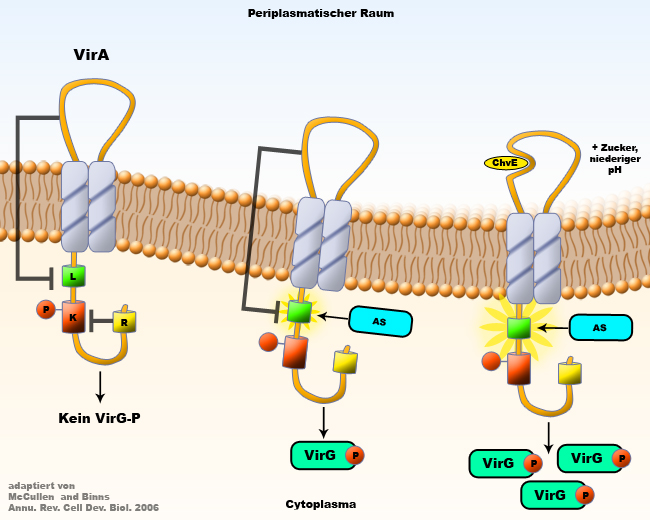Team:Bielefeld-Germany/Project
From 2010.igem.org
| Line 2: | Line 2: | ||
== '''The Project''' == | == '''The Project''' == | ||
| - | + | [[Image:Vira_rezeptor.jpg|200px|thumb|right|The VirA receptor of ''agrobacterium tumefaciens'']] | |
The aim of the iGEM-Team Bielefeld is to modulate a receptor from ''agrobacterium tumefaciens'', to make it sense capsaicine. Capsaicine is responsible for the spiciness in chili and pepper - and hence in a lot of food. The idea behind is to make the spiciness of food visible via some kind of traffic light. Brought into ''escherichia coli'', this modulated system will induce light effects of different intensities - depending of the spiciness of the sample. | The aim of the iGEM-Team Bielefeld is to modulate a receptor from ''agrobacterium tumefaciens'', to make it sense capsaicine. Capsaicine is responsible for the spiciness in chili and pepper - and hence in a lot of food. The idea behind is to make the spiciness of food visible via some kind of traffic light. Brought into ''escherichia coli'', this modulated system will induce light effects of different intensities - depending of the spiciness of the sample. | ||
Revision as of 18:25, 10 August 2010
The Project
The aim of the iGEM-Team Bielefeld is to modulate a receptor from agrobacterium tumefaciens, to make it sense capsaicine. Capsaicine is responsible for the spiciness in chili and pepper - and hence in a lot of food. The idea behind is to make the spiciness of food visible via some kind of traffic light. Brought into escherichia coli, this modulated system will induce light effects of different intensities - depending of the spiciness of the sample.
Originally, the receptor from agrobacterium tumefaciens detects acetosyringone, a secondary metabolite of plants which attracts the bacteria. Binding to the receptor, acetosyringone induces an intracellular signal transduction which finally results in the bacterias chemo taxis towards the plant. By changing the binding region of that receptor via directed evolution we want it to be capable of detecting other compounds. The gained system will be brought into escherichia coli and it will lead to a light signal.
Besides capsaicine there are other potentially detectable compounds of interest, like dopamine, adrenaline or near derivates. Environmental toxins and allergens are possible targets for modulated receptors and might be quantitated by light signalling.
After all, a broad range of compounds that can be quantitated with both, high sensitivity and specifity by our bio sensor is our greatest aim. Such fast and sensitive biological systems can e.g. be applied in the quality control of the production of nutritions. Production chains might be saved from dangerous compounds.
Das Projekt
Das iGEM-Team Bielefeld stellt sich der Herausforderung, einen Rezeptor aus Agrobacterium tumefaciens dahingehend zu modulieren, dass er schließlich Capsaicin sensieren kann. Capsaicin ist für die Schärfe in Chili und Pfeffer - und damit in vielen Nahrungsmitteln - verantwortlich. Dahinter steckt die Idee, den Schärfegrad einer Speise über eine Art Ampel sichtbar zu machen. In das Bakterium Escherichia coli eingebracht, soll das modulierte System zu verschieden intensiven Leuchteffekten führen, je nachdem wie scharf eine Probe ist.
Der original Rezeptor aus Agrobacterium tumefaciens detektiert normalerweise Acetosyringon, ein Sekundärmetabolit, das von Pflanzen hergestellt wird und den Bakterien als Lockstoff dient. Bindet Acetosyringon an den Rezeptor, löst dies eine intrazelluläre Signaltransduktion aus, die schlussendlich zu Chemotaxis der Bakterien in Richtung der Pflanze führt. Das Ziel ist die Binderegion des Rezeptors mittels gerichteter Evolution dahingehend zu verändern, dass er andere Stoffe detektiert. Das so gewonnene System wird in Escherichia coli eingebracht und zur Synthese eines Lichtsignalmoleküls führen.
Neben Capsaicin sind weitere potentiell detektierbare Substanzen im Gespräch, wie etwa Dopamin, Adrenalin oder nahe Derivate. Umweltgifte und Allergene könnten ebenfalls ein Ziel eines modulierten Rezeptors sein und per Lichtsignal quantifiziert werden.
Insgesamt wäre eine große Bandbreite an quantifizierbaren Stoffen vereint mit einer hohen Sensitivität und Spezifität des Biosensors das größte Ziel des Teams. Derart schnelle und sensitive biologische System könnten unter Anderem in der Qualitätskontrolle bei der Nahrungsmittelproduktion eingesetzt werden. Unerwünschte oder gefährliche Stoffe könnten erkannt werden, bevor sie in die Produktionskette gelangen.
 "
"



